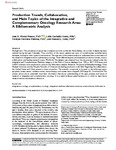Mostrar o rexistro simple do ítem
Production trends, collaboration, and main topics of the integrative and complementary oncology research area: a bibliometric analysis
| dc.contributor.author | Moral-Muñoz, José A. | |
| dc.contributor.author | Carballo-Costa, Lidia | |
| dc.contributor.author | Herrera-Viedma, Enrique | |
| dc.contributor.author | Cobo, Manuel J. | |
| dc.date.accessioned | 2019-05-20T09:37:59Z | |
| dc.date.available | 2019-05-20T09:37:59Z | |
| dc.date.issued | 2019-05-03 | |
| dc.identifier.citation | Moral-Munoz JA, Carballo-Costa L, Herrera-Viedma E, Cobo MJ. Production trends, collaboration, and main topics of the integrative and complementary oncology research area: a bibliometric analysis. Integr Cancer Ther. 2019 Jan-Dec;18:1534735419846401. | es_ES |
| dc.identifier.issn | 1534-7354 | |
| dc.identifier.uri | http://hdl.handle.net/2183/22920 | |
| dc.description.abstract | [Abstract] BACKGROUND: The prevalence of cancer has increased over time worldwide. Nevertheless, the number of deaths has been reduced during the past 2 decades. Thus, one-third of the cancer patients are users of complementary and alternative therapies, looking for other types of interventions. The main aim of the present study is to understand the current status of the research in integrative and complementary oncology. Three different aspects were analyzed: production trends, country collaboration, and leading research topics. METHODS: The dataset was obtained from the documents indexed under the Integrative and Complementary Medicine category of the Web of Science database from 1976 to 2017. VOSviewer and SciMAT software were employed to perform the bibliometric analysis. RESULTS: The Journal of Ethnopharmacology, China Medical University and the People's Republic of China are the leading producers in the field. Regarding the collaboration, the United States and China present a close connection. The scientific community is focused on the following topics: apoptosis, breast cancer, oxidative stress, chemotherapy, and nuclear factor-Kappa-B (NF-Kappa-B). CONCLUSIONS: The present article shows potentially important information that allows understanding of the past, present, and future of research in integrative and complementary oncology. It is a useful evidence-based framework on which to base future research actions and academic directions. | es_ES |
| dc.description.sponsorship | The author(s) disclosed receipt of the following financial support for the research, authorship, and/or publication of this article: The authors want to thank the support of FEDER funds (TIN2016-75850-R) and University of Cádiz project (PR2017-038). | es_ES |
| dc.description.sponsorship | University of Cádiz; PR2017-038 | es_ES |
| dc.language.iso | eng | es_ES |
| dc.publisher | Sage | es_ES |
| dc.relation.uri | https://doi.org/10.1177%2F1534735419846401 | es_ES |
| dc.rights | Creative Commons Attribution-NonCommercial 4.0 International License (CC-BY-NC 4.0) | es_ES |
| dc.rights.uri | http://creativecommons.org/licenses/by-nc/4.0/ | * |
| dc.subject | Alternative medicine | es_ES |
| dc.subject | Bibliometrics | es_ES |
| dc.subject | Complementary oncology | es_ES |
| dc.subject | Integrative medicine | es_ES |
| dc.subject | Integrative oncology | es_ES |
| dc.subject | Scienciometrics | es_ES |
| dc.title | Production trends, collaboration, and main topics of the integrative and complementary oncology research area: a bibliometric analysis | es_ES |
| dc.type | info:eu-repo/semantics/article | es_ES |
| dc.rights.access | info:eu-repo/semantics/openAccess | es_ES |
| UDC.journalTitle | Integrative Cancer Therapies | es_ES |
| UDC.volume | 18 | es_ES |
Ficheiros no ítem
Este ítem aparece na(s) seguinte(s) colección(s)
-
GI-IPRF - Artigos [152]






